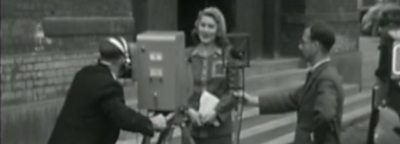Lord Hankey presided over a committee that considered developments elsewhere - most notably in the United States. After RCA launched a television service in 1939, the Americans concluded that the new medium would have to sink or swim in a commercial market. Britain, conscious that our pre-war service had been an expensive luxury from which only a few people had benefited, was bound to consider the commercial option too.
Furthermore, the National Television Systems Committee (NTSC) in the US had adopted a 525-line standard for the US, offering potentially higher definition than the 大象传媒's 405 lines.
So the Hankey Committee went back to basics, and their blue-skies thinking produced some remarkable ideas. Sensing that television could replace the cinema, they recommended 'vigorous research work' on an improved system of television with up to 1,000-line definition, possibly with the 'introduction of colour and stereoscopic effects' (3D). It was also decided that the television service must be extended to 'six of the most populous areas outside London '.
The recommendations, published in March 1945, prompted EMI to start work on a new standard, but it would be over three years before they were able to demonstrate a working prototype 1001-line TV system. Similarly, the Post Office (which was responsible for the regulation and licensing of all transmitters), began researching how the national coverage of TV might be achieved.

The most obvious solution was to raise a transmitting aerial to a great altitude, so it could deliver signals to the whole of the UK from a single transmitter. A number of fantastic schemes emerged.
One such involved building a transmitting tower more than a mile high in north London (the idea was shelved because of the 'risk to aircraft and also to the surrounding area in the event of a tower failure'). Another involved an aerial supported by a massive hydrogen balloon; and others advocated a technique called 'stratovision', which had already been tested in the US.
It involved an aircraft constantly circling at a height of some miles carrying the transmitter and aerial. Although technically feasible, it was ruled out on the grounds of cost.
In the end the Government took the only practical route for a nation impoverished after five years of war. The 405-line service, funded by the licence fee, would return, and in time four new transmitting stations would be built to extend the service to major population centres outside London. This would have the added benefit of driving the mass production of television sets, thus bringing down unit costs and making the medium more affordable for everyone.
So the returning engineers and production staff mustered once more at Alexandra Palace, and on 7 June 1946, the day before the first anniversary of Victory in Europe, television was back.
Launch day
At a time when other nations were beginning to launch their services from scratch, the 大象传媒 set out to remind viewers that it had been there first. Presenter Jasmine Bligh reintroduced herself to viewers with the words: 'Remember me?'
The first programme was a repeat of the last programme transmitted before the shutdown in 1939 - that Disney cartoon, Mickey's Gala Premiere. And the first day's schedule included the Mantovani Orchestra - which had been scheduled to play on the day the transmitter was switched off in 1939.
The service promised to be an improvement on pre-war television: better pictures (thanks to advances in cathode ray tube technology), and an expanded schedule (up from the pre-war two hours a day to three).
The return was auspicious. On day two the 大象传媒 deployed cameras in the Mall and Trafalgar Square for the VE Day parade. The 大象传媒's 'finest two hours' (Sunday Chronicle) brought viewers the RAF fly-past, Princess Elizabeth in an ostrich feather hat, and 'the cufflinks on Mr Churchill's sleeves and the bristles of Mr Attlee's moustache'.
